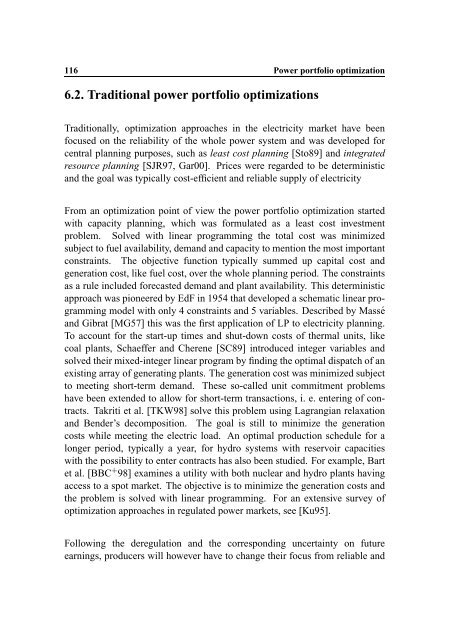Hedging Strategy and Electricity Contract Engineering - IFOR
Hedging Strategy and Electricity Contract Engineering - IFOR
Hedging Strategy and Electricity Contract Engineering - IFOR
Create successful ePaper yourself
Turn your PDF publications into a flip-book with our unique Google optimized e-Paper software.
116 Power portfolio optimization<br />
6.2. Traditional power portfolio optimizations<br />
Traditionally, optimization approaches in the electricity market have been<br />
focused on the reliability of the whole power system <strong>and</strong> was developed for<br />
central planning purposes, such as least cost planning [Sto89] <strong>and</strong> integrated<br />
resource planning [SJR97, Gar00]. Prices were regarded to be deterministic<br />
<strong>and</strong> the goal was typically cost-efficient <strong>and</strong> reliable supply of electricity<br />
From an optimization point of view the power portfolio optimization started<br />
with capacity planning, which was formulated as a least cost investment<br />
problem. Solved with linear programming the total cost was minimized<br />
subject to fuel availability, dem<strong>and</strong> <strong>and</strong> capacity to mention the most important<br />
constraints. The objective function typically summed up capital cost <strong>and</strong><br />
generation cost, like fuel cost, over the whole planning period. The constraints<br />
as a rule included forecasted dem<strong>and</strong> <strong>and</strong> plant availability. This deterministic<br />
approach was pioneered by EdF in 1954 that developed a schematic linear programming<br />
model with only 4 constraints <strong>and</strong> 5 variables. Described by Massé<br />
<strong>and</strong> Gibrat [MG57] this was the first application of LP to electricity planning.<br />
To account for the start-up times <strong>and</strong> shut-down costs of thermal units, like<br />
coal plants, Schaeffer <strong>and</strong> Cherene [SC89] introduced integer variables <strong>and</strong><br />
solved their mixed-integer linear program by finding the optimal dispatch of an<br />
existing array of generating plants. The generation cost was minimized subject<br />
to meeting short-term dem<strong>and</strong>. These so-called unit commitment problems<br />
have been extended to allow for short-term transactions, i. e. entering of contracts.<br />
Takriti et al. [TKW98] solve this problem using Lagrangian relaxation<br />
<strong>and</strong> Bender’s decomposition. The goal is still to minimize the generation<br />
costs while meeting the electric load. An optimal production schedule for a<br />
longer period, typically a year, for hydro systems with reservoir capacities<br />
with the possibility to enter contracts has also been studied. For example, Bart<br />
et [BBCœ al. 98] examines a utility with both nuclear <strong>and</strong> hydro plants having<br />
access to a spot market. The objective is to minimize the generation costs <strong>and</strong><br />
the problem is solved with linear programming. For an extensive survey of<br />
optimization approaches in regulated power markets, see [Ku95].<br />
Following the deregulation <strong>and</strong> the corresponding uncertainty on future<br />
earnings, producers will however have to change their focus from reliable <strong>and</strong>
















